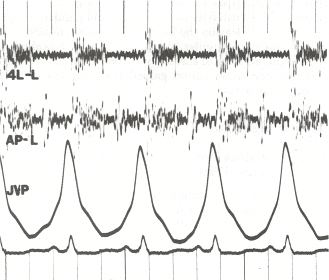ICD-9-CM 89.55 | ||
 | ||
A phonocardiogram (or PCG) is a plot of high-fidelity recording of the sounds and murmurs made by the heart with the help of the machine called the phonocardiograph; thus, phonocardiography is the recording of all the sounds made by the heart during a cardiac cycle. .
Contents
Medical use
The sounds result from vibrations created by closure of the heart valves, there are at least two: the first when the atrioventricular valves close at the beginning of systole and the second when the aortic valve and pulmonary valve close at the end of systole. It allows the detection of subaudible sounds and murmurs, and makes a permanent record of these events. In contrast, the stethoscope cannot always detect all such sounds or murmurs, and it provides no record of their occurrence. The ability to quantitate the sounds made by the heart provides information not readily available from more sophisticated tests, and it provides vital information about the effects of certain drugs on the heart. It is also an effective method for tracking the progress of the person's disease.
Discrete and the packet wavelet transform
According to a review by Cherif et al, discrete wavelet transform DWT is better at not affecting S1 or S2 while filtering heart murmurs.Packet wavelet transform affects internal components structure much more than DWT does.
History
John Keefer filed a patent for the phonocardiogram in 1970 while he was an employee of the U.S. government. The original patent description indicates that it is a device which via electrical voltage mimics the human hearts sounds.
